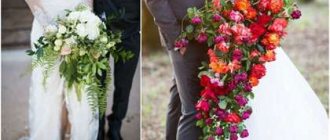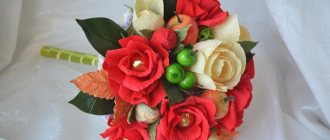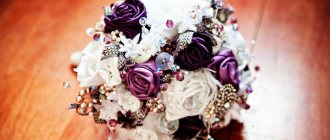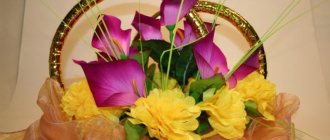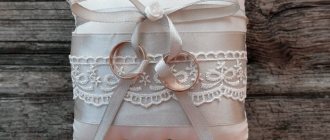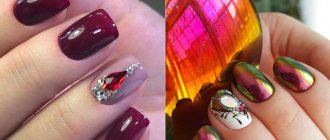How to sew a simple veil with your own hands
Sewing does not require much time or sewing skills. You can involve girlfriends or sisters in the process.
White tulle veil
For independent creativity, they initially stock up on the necessary materials. Before making a batting veil for a bachelorette party, prepare:
- a piece of fabric measuring 2x1 m, white;
- milky satin ribbon for edging;
- light beads made of artificial mother-of-pearl;
- scissors, needle and thread, hair clip.
Pattern based on a square
Having collected all the necessary materials, we begin the creative process:
- On a flat surface, in particular on a table, place a piece of fabric measured to size and fold it lengthwise to form two equal parts. Then it is folded again, but now doubled across.
- Armed with scissors, they cut off a corner in order to give the ends of the future veil a rounded shape.
- Then they unfold the cut fabric and, using a needle and thread, carefully baste a satin ribbon along the edge of the veil, after which they finally sew it on with a zigzag machine.
- At the next stage, the fabric is folded so that the top layer of the future veil is slightly shorter than the bottom.
- To ensure that the accessory is correctly placed on the top of the head, the material is gathered in the middle with a fine seam, departing from the edge on both sides by approximately 22 centimeters. The result is a gathered top.
- The veil is secured using a hair clip, which is sewn to the fabric on the reverse side.
- For decoration, an artificial flower is made, for which five circles of different diameters are cut out of the same material and folded as they decrease in size. The resulting decor is sewn in the middle, then faux pearl beads are glued in the center. Finally, the flower is sewn to the top of the veil.
Sewing patterns
Ideas for sewing and decor
For decoration, various decorations are used, which are added during the sewing process. These can be artificial daisies, roses, chrysanthemums with a scattering of transparent beads that act as dew drops, small feathers and lace.
Using layers will help you sew a lush veil for a bachelorette party. The secret is that the width of the piece of fabric should be two to three times its length. The resulting folds will give the product the necessary volume. In addition to tulle, tulle, organza, lace, mesh, and veil can serve as materials for creating a textile masterpiece.
Circle-based sewing option
A veil at a bachelorette party makes the bride’s image unique and memorable, creating a special atmosphere on the eve of the special wedding day. The hair attribute is original in that it has many variations, from which it is easy to choose the one most suitable to the character and internal state of its owner.
How to sew a veil yourself: step-by-step instructions
So, you can get started:
- First, you should lay out the selected fabric on a convenient surface, and then fold it in half lengthwise. And then transversely again. You should get a rectangle in four layers.
- Now you need to fasten all the layers so that they do not diverge, mark a line and use scissors to round the fabric along it. By unfolding the material, you can see a rectangle.
- Next, you can give the veil its shape. The material should be folded crosswise. If you are planning a multi-layer veil, then you need to fold it not in the middle, but make the end of the fabric slightly longer than the second.
- It's time to try on what's coming out. If it turns out longer than planned, then you need to slightly trim all the excess.
- Now you can assemble the veil. Using a needle and thread, you need to gather the material into folds. If the veil must be very thick, then you need to collect the material along the entire width. In other cases, it is enough to collect only the middle piece of material along the fold. There should be a section of collected material of 5 centimeters.
- Now you can sew the resulting veil to the hairpin.
- All that remains is to decorate the veil. The lower part can be decorated manually with a needle or, for speed, you can use a sewing machine, but this must be done extremely carefully.
That's all. Now a hand-sewn veil will be useful not only for your wedding. It can be made into a family heirloom and passed on from generation to generation.
| Injections are a thing of the past! It's so simple! You will be shocked... Read more >>> |
| This is how Kamenskikh loses weight! The recipe from Nastya Kamenskikh blew up the Internet! Read details >>> |
Materials and tools
Recommendations and notes on choosing fabric:
- Tulle produced in the European Union and America is better suited for children's clothing. This fabric is soft, pleasant to the body and does not flare up when hit by a spark. The material of the same name, produced in China, is usually rougher than the European one and does not meet international fire safety requirements. When exposed to flame, it instantly bursts into flames.
- Stiff tulle has scratchy seams and edges, so a dress made from it must have a petticoat, otherwise the tights will tear or the legs will be scratched. The underskirt can be made from knitted fabric, thick satin, or from the same fabric from which the bodice is made.
- For a long skirt, buy soft material, it will fall beautifully. Hard tulle is more suitable for a tutu. If in doubt, choose a material with medium hardness. It will make a fluffy bottom that will neither puff up nor fall down.
- It is easier to form a multi-layered or long hem from a wide cut. A narrow cut - this is usually how stiff tulle is sold - use it on a very short tutu skirt.
- Soft tulle needs to be purchased with a reserve. Hard ones have less consumption.
- In addition to tulle and material for the petticoat, you will need fabric for the top. When choosing fabric, consider whether a tight-fitting or slightly loose top looks good with a tutu.
From a wedding story
In ancient times, a wedding veil was preceded by a crown, or wreath. This is a circle of flowers and herbs woven in an arc, which was placed on the bride’s head and symbolized the unity of the future family. Since on Ivan Kupala the girls wove wreaths, dipped them in the water and asked the betrothed to find her by the wreath.
Among the eastern peoples, the girl was completely clothed in a blanket and removed by the young husband after the wedding, or even after the wedding itself. It was believed that in this way the bride was protected from the evil eye, envy and evil intentions.
Among other peoples at different times, the wedding veil and its variations performed the same function: protection of the bride and her future family, protection of the sacred sacrament.
There are many traditions and superstitions regarding the bride’s wedding dress, but some of the most fundamental ones relate to the veil.
DIY veil for marriage registration
The registry office does not have any strict requirements regarding attire, and therefore it is allowed to use any ideas for making a veil in order to create a truly individual option that is ideally suited to a specific toilet. The sewing pattern, by and large, remains unchanged, but the product can be based not only on a rectangle. For example, options with a sharp long bottom edge, 2 tiers and waist length are popular. This veil is created on the basis of a diamond; its pattern is presented below.
Depending on the style of the product, the fabric is chosen, but it is most interesting to make it from chiffon or guipure. Beads are recommended for decoration, and the veil itself can become a little more fluffy and voluminous if you create 4 tiers instead of 2: you will need not 1, but 2 diamonds. In most cases, such a product is attached to a comb or several long pins and does not cover the entire head, but only the occipital area. Therefore, an asymmetrical veil becomes a companion to low buns and wavy hair barely pulled back.
Large squares, which are best made different in size by 5-10 cm, are processed around the perimeter using any of the previously discussed methods: fire, overlock or satin ribbon. After which the rhombus is visually divided by a transverse line into 2 triangles and the upper corner is bent outward. It is optimal to maintain the length of this tier so that it is 2 times greater than the remaining height of the upper triangle.
The layers of the veil are inserted into each other, in the middle of the fold they are fastened and placed on a thread, after which they are assembled by tightening 30-40 cm. Then at this point you need to attach the product to a hairpin: hairpins or a comb.
The final stage is decorating the finished veil. You can only hide the attachment point by decorating it with pearls, crystals, fabric or artificial flowers. You can spend several hours embroidering the lower tier of the veil with beads or covering it with rhinestones. The main thing is to remember the need to match the patterns on the veil with those on the dress.
Another option for creating a dress with your own hands
A casual dress can be created from a blouse. This method is good because it saves a lot of time. No need to sew top or bodice. The bottom will look like a ballet skirt.
Necessary materials:
- jacket (one-piece, not with buttons or zippers);
- tulle (1 meter);
- knitwear for petticoat (50 cm);
- wide elastic band (note that it will go over the top and not be sewn in).
Dress making process:
- Try on the jacket. Mark the place that coincides with the girl's waist line.
- Cut off everything from the jacket that lies below the marked line.
- Sew an elastic band to the bottom of the blouse.
- From the knitwear, cut 2 trapezoidal sections for the front and back of the petticoat. To determine the width of the edge, use a jacket.
- Form a two-layer skirt from tulle.
- Sew the petticoat to the skirt
- Sew the bottom of the dress to the elastic from the top.
Instead of a sweater, a crocheted or knitted top is also suitable. Determining the number of loops is easy. To do this you need to know your chest circumference. Based on these parameters, a seamless bodice is knitted in a circle.
You can get an interesting ball gown if you use a wide mesh elastic band (not underwear, but mesh) as the top and base for the skirt. Cut and form a bodice out of it, and then through several lower rows of elastic, pass the required amount of stiff tulle, cut into ribbons. This method is good because it allows you to get an asymmetrical hem without creating a complex pattern. And at the same time you can play with the level of the beginning of the hem. To do this, the pieces of fabric on one side of the mesh begin to be woven several holes higher than on the other.
A long tutu skirt formed from tulle patches can easily be turned into a dress. To do this, a closed elastic band is threaded through the layers of tulle (closed means that its ends are sewn together and form a circle). Each ribbon is tied around an elastic band and secured with a knot. Having finished tying the first elastic band, take the second elastic band, place it a little lower than the first and do exactly the same actions with it. The result is a top that fits tightly to the body around the elastic bands. The loose remnants of the cuts in this dress become the hem.
If the transition from a tight-fitting corset with elastic bands to a fluffy hem seems too abrupt, then it’s worth adding a belt. Usually, a 10 cm wide ribbon is used for it. If a silk strap is inappropriate, try a tulle cut or a wide linen elastic band. Since tulle fabric, due to its rigidity, does not always make a beautiful bow, it is worth looking at a brooch for the place where the ends are fastened. The decoration will cover the knot.
How to make a veil for a bachelorette party with your own hands?
A modern bachelorette party scenario, as well as the theme of the upcoming holiday, will help you decide on the design of the veil for the bride. Take advantage of practical advice from the Svadbaholik.ru portal:
- For a celebration in a restaurant, choose a neat veil in light colors.
- Are you having a bachelorette party outdoors? Give preference to a light green model with floral motifs.
Options for attaching a veil to the bride's head
When choosing a veil design for a bachelorette party and analyzing the different types of wedding veils, you need to think about an important detail: how to attach it to the bride's hair? Let's look at the most convenient mounting methods:
- Headband. The simplest mounting option. You can decorate the headband itself in various ways: from rhinestones and beads to feathers and flowers.
- Invisible or stiletto heels. Ideal and most convenient for attaching miniature and light veils. Suitable for any hairstyle, they look best on collected hair.
- Automatic hairpin. Suitable for a collected hairstyle.
Interesting: In addition to the above options, you can use a comb, tiara, hat or cap to attach a veil to a bachelorette party.
Jewelry styles
Large selection for every taste:
- Fantasy . Often from several panels, with corners, ribbons, frills.
- Classic . Doesn't cover the head. It is usually attached to the bottom of the hairstyle. The veil is worn only at the beginning of the celebration.
- Wedding . The head is completely covered. Complemented with flowers, hairpins, and a tiara.
- Wedding veil-veil (mantilla). Inspired by oriental or Spanish motifs. It is a thin transparent blanket, fixed with several invisible ones.
- Veil with head decoration frame . Sometimes a complex hairstyle is not meant; there is a frame made of beads, seed beads, flowers, which practically covers the head, and the bedspread is attached to it.
How to choose?
Choosing a hat is not so easy. You should not just like it, but fit many parameters. What should you consider when choosing this wedding accessory?
Main selection criteria:
Features of appearance. You need to choose a wedding headdress based on your face shape. A model with an upturned brim will be appreciated by brides with a wide face. Flat hats with wide brims are suitable for thin girls with pointed features. “Pills” will be good for those with a round face shape.
Peculiarities of height and figure, oddly enough, can also influence the choice. So, wide-brimmed hats will look great on tall girls; Brides with curvy figures should not purchase miniature options. When choosing a wide-brimmed hat, fragile brides should make sure that the brim of the hat does not extend beyond the shoulder line.
Bride's age. Young beauties are allowed bold options, such as a top hat, cap or cowboy hat
More mature brides should pay attention to elegant models with a minimum of decor.
The styles of the wedding dress and hat should be in harmony. Bridal hairstyle. Perhaps you have already completely planned your look, and you see the hat as just an unusual addition.
It is worth thinking about what kind of headdress will suit your future hairstyle.
Wedding style. If there is a themed event, then the hat should match it. For example, at a Mafia-style wedding, an original veil would be appropriate; at a Boho-style celebration, a wide-brimmed hat would be appropriate.
It's wedding season. The time of year also dictates its own rules when choosing a hat. So, in winter you can pay attention to hats trimmed with fur, in the spring and summer months - to light headdresses decorated with a floral arrangement.
The quality of the materials from which the product is made. Don't skimp on quality and buy a cheap hat. Preference should be given to fabrics such as satin, organza, linen, and lace.
Pairing with a wedding dress
A hat is just an elegant accessory that is designed to complement the bride's image. The wedding dress still remains the center of attention, so you need to choose a headdress so that it is in harmony with the style and style of the outfit.
It is worth noting that hats look best with short, tight-fitting dresses, skirt or trouser suits. The “pill” style is ideal for a short dress, and the wide-brimmed model is ideal for a long one. “Vullet” will perfectly complement a light, fluffy dress.
The color of the headdress does not have to match the color of the dress
However, it must be borne in mind that a combination of cold and warm shades is highly undesirable. Pay attention to the material from which the hat is made. The texture of the fabric should be as close as possible to the fabric of the dress
Otherwise the difference will be very visible in the photographs. An incomplete match of decorative elements on the hat and dress is acceptable.
Fabric for veil
If the bride wants the veil to keep its shape, she will need to buy stiff fabric. Soft material is suitable for flowing, falling styles of a wedding bedspread. The fabric is selected to match the dress.
Most often used for sewing:
- Fatin. Can be hard or soft.
- Guipure. A piece of clothing made from this material looks rich and delicate.
- Veil. This is the same tulle, but with a fine mesh.
- Tulle. This material can be purchased at a curtain store. There are many white, thin curtains on sale now.
- Organza. The material is rigid and retains its given shape well. The only drawback is that the edges fray at the cut site, so during the process it is recommended to use a French seam, thanks to which the cuts will be stitched inside the seam.
- Lace. This material is most often used to decorate veils made from tulle or veil.
Tulle is used to make veils
Choice of fabric and trim
Fabrics used for sewing wedding veils are divided into two groups - hard, holding their shape well, and soft - flowing, cascading . We choose the type of material depending on the cut of your dress.
Most often used:
- Tulle is a special fine mesh. It can be hard and soft, smooth and decorated.
- Guipure.
- Veil.
- Tulle.
- Organza.
- Lace.
Advice! If you can’t decide on a fabric for a long time and still don’t have the right one, pay attention to curtain stores. Some types of drapes made from thin white fabric may work well. A large number of translucent lace or mesh veils and tulles are now produced.
How to attach a veil to loose hair
Attaching a veil to loose hair is a separate issue. There are various ways to secure jewelry. Some of them are considered universal, others are suitable for hairstyles with half-down hair, like a molly.
The way the veil is attached to the head is not affected by styling. Let's consider the nuances.
Method 1: On a braid
To attach a veil to loose wavy hair, it is not enough to arm yourself with hairpins. It is necessary to prepare the frame. To do this, the master weaves a hidden braid at the place where the veil is attached. It blends harmoniously with curls and is not visible under voluminous styling.
The braid is secured with bobby pins, and a veil with stiletto heels or a comb is attached to it.
Method 2: Backcombing with a comb
Disguising a braid under perfectly smooth hair is more difficult than hiding it in curls, so with this hairstyle the hairdresser does a backcomb. It, like a braid, is covered with a strand of hair. Then I install the veil with bobby pins, bobby pins, and a comb.
Method 3: Invisible
Modern craftsmen, instead of backcombing or braids, make a frame for a veil from invisible ones. This method is suitable for both curls and straight hair.
The bobby pins are attached in a cross-shaped manner, which allows you to tightly attach the hairpins with the veil to your hairstyle. If the wedding hairstyle is a little one, the veil is attached in the place where the strands of the temporolateral zones connect. After all, hairpins and bobby pins are already used there.
Method 4: with a crown or tiara
Another way to attach a veil to loose curls or straight hair is to use wedding jewelry. In this case, the accessory is initially sewn to the crown or tiara. Stylists call this option outdated, but brides choose it. This is a convenient way, because after the formal part you can easily get rid of the veil without ruining your hair.
Design and color
The wedding attribute is sewn from white fabrics, choosing the style to your liking.
- Fantasy. It is made from several layers of fabric, decorated at the edges with ribbon or frills. The bottom edge may be oval or angled.
- Classical. This is a bunch of collected lightweight material that is attached to the bottom of the hairstyle. Most often, such an attribute does not have additional decorations. The veil covers the bride's face only during the formal part of the holiday.
- Wedding. Since a girl must enter church only with her head covered, the veil must meet this requirement. The hair is completely covered with fabric, complemented by rich accessories in the form of a wreath, tiara, and hairpins.
Wedding
- Mantilla. Lovers of Spanish or oriental style will appreciate this piece of jewelry, made of thin white material. Fixed on the hair using bobby pins.
- Veil attached to head decorations. A similar wedding crown is made from beads, flowers and seed beads. Before fixing it on the bride's head, a veil is sewn to it.
How to make a veil for a bachelorette party?
Trying on a wedding dress and veil is the dream of most girls. But even if your own wedding is still “in the works,” there is always the opportunity to show off in a flirty veil at a friend’s bachelorette party.
What should it be?
A traditional long and fluffy veil is an attribute of a wedding. For a bachelorette party, a frivolous short and bright model is more suitable.
Since the event is usually held actively, often in a club or in the fresh air, the gathered girls have a logical desire to stand out from the crowd and at the same time not complicate the outfit with uncomfortable accessories.
Therefore, the veil for a bachelorette party is light, short, and not too fluffy. To attach to hair or a headdress (hat, baseball cap), hairpins, clips, hoops, small combs or bobby pins are used.
When choosing an accessory, you need to consider:
- a clear difference between the bride and the bridesmaids. The difference may be in the color of the veil, its length and/or shape, and decorations. Often, before the wedding, girls choose a model made of white tulle, organza or chiffon, supplying their friends with colored ones - red, green, blue;
- method of attaching the product to the head. For short haircuts of bachelorette party participants, it is better to choose hoops or hats/baseball caps; for long hair, hairpins and bobby pins, combs are suitable; in the hairstyle, it is more convenient to fasten the veil with hairpins or a comb (for example, in the style of a Spanish mantilla);
- correspondence of the style and color of the product to the bridesmaids’ outfits and the location of the bachelorette party.
How to do it yourself?
There are several options for a veil for a bachelorette party, but they are all united by the comparative ease of manufacture and small size - this is a one-time accessory, it should not cost too much or be labor-intensive to create.
Popular models based on:
- square (rhombus). A square piece of fabric is folded so that one corner is folded over the main part of the piece;
- rectangle with rounded corners. You can fold it in half lengthwise or widthwise, making two tiers of different lengths. Depending on the type of fold and size of the flap, a more or less fluffy veil is obtained;
- circle. The fold line can be made in the middle of the circle or offset. In the first case, the veil turns out to be more magnificent, all of the same length. In the second - with a pronounced division into tiers;
- oval or half circle with a semicircular neckline.
List of materials
To create any of the simple options for a small veil for a bachelorette party you will need:
- a piece of light fabric (tulle, organza, stiff silk or mesh). The size of the flap depends on the desired model. On average, a piece with a diameter/side of 30-60 cm is enough;
- a product with which the veil will be attached to the head - a comb, a hoop, a hairpin or clip, a hairpin. It is convenient to attach the model to a headdress - a hat or an original baseball cap;
- matching threads with a sharp thin needle;
- decorations - artificial flowers, rhinestones, beads, bows or ribbons;
- superglue or hot melt glue (as needed).
Instructions
Depending on the model and decorations, the techniques for making veils vary. Let's look at how to sew a mini veil step by step.
Main stages:
- cut the fabric. It is better to cut the flap folded (in half, in four);
- edge processing (if necessary). The easiest way is to heat the edge of the synthetic fabric over the fire of a candle, match or lighter. You can trim the edge with braid, lace, thin ribbon using a sewing machine or by hand;
- gathering along the fold line or along the edge. To do this, lay a basting seam manually and tighten the product onto a thread;
- fastening to the holder. The easiest way is to sew the gathered fabric to a pin or hoop using large stitches. If there is sufficient contact area, gluing is possible;
- fixing jewelry. The method depends on the chosen type of decor, its quantity and the skill of the performer.
In a simpler version, you can do without sewing. This product is fastened with studs or invisible ones.
Video: short veil
Making a veil that will be attached with a hairpin:
Making a veil for a bachelorette party yourself is an easy task even for an inept dressmaker. Making an accessory may well become part of the holiday; the creative process will help girls tune in to the right mood and show their imagination.
DIY veil: step-by-step instructions on how to make a veil
Preparing for a wedding celebration is filled with pleasant chores, excitement and unforgettable emotions. A DIY veil can add originality and uniqueness to the bride’s image. Making this accessory is not difficult, let's figure it out.
Deciding on the style
Deciding on the style
The veil is that attribute of the bride’s image that creates mystery, purity and lightness. Snow-white light fabric covers the head and rests on the shoulders, charming and delighting.
Before you start making your own, you need to decide on the purpose and style. Perhaps a girl needs a veil for a bachelorette party. In this case, the patterns and sewing technology will be different (complex patterns and expensive fabrics will not be needed here).
How to make a veil with your own hands for a wedding? First of all, you need to purchase a dress (so that the finished accessory looks good and matches well).
- With a full skirt, the veil should be equally voluminous, but short, with a minimum of additional decorations.
- For a mermaid dress, long fabric that flows in light waves is suitable.
- For simple silhouettes - a delicate veil.
Patterns also differ depending on the nuances of the ceremony.
If there is a wedding in a church, the veil should completely cover the head.
If young people are limited to the registry office, an option for attaching it to the back of the head (on the hairstyle) is acceptable.
Preparatory stage
Preparatory stage
Let's approach making a veil with your own hands step by step.
Before sewing a veil, be sure to familiarize yourself with all the stages of work.
It is important to collect the necessary tools and materials so as not to be distracted during the manufacturing process
Preparing the tools
Preparing the tools
So, what will you need? The required list includes:
- material (usually tulle);
- white threads (silk or cotton);
- sharp scissors and needle;
- sewing machine;
- bobby pins for fastening (5-10 pieces), it is preferable to take metal ones - they guarantee strength;
- hairpin to match your hair color.
The amount of material is determined based on the desired length.
For a veil to the shoulders you will need 50-60 cm of fabric, to the elbow area - 80 cm, to the fingertips - 110 cm. If you are planning a train, you need at least 2 meters of fabric.
It is also important not to forget to add to the indicated length a supply of fabric for seams (5-15 cm)
Choice of material and finish
Choice of material and finish
The very first action after you have outlined a plan is to buy fabric.
The optimal choice is tulle mesh. An alternative is lace or tulmarine.
Tulle is divided into types depending on the shape of the cells and their rigidity (drape, the size of the folds, and shape retention also depend on this). To make the right choice, apply different types of material to your head and compare the effect.
The easiest option is to trim the edges with scissors. But it will look more beautiful and profitable with decoration. For these purposes you can take:
- stitched fishing line (the effect of a wavy-curly cut);
- patterns and embroidery;
- lace;
- braid with rhinestones;
- jagged folds.
You can complement the overall design by sewing (or gluing) decorative decorations throughout the canvas.
Let's start the pattern
Let's start the pattern
Among the most common tailoring shapes are the traditional rectangle or oval. At the request of the bride, these options can be replaced (a shape in the form of part of a circle, a rectangle with round edges is welcome).
Veil pattern: how to do it correctly?
- First you should make a paper pattern (life-size).
- We fold a sheet of size 170x170 in half (direction from left to right), then fold it again, but from top to bottom.
- We fold the resulting blank diagonally (from the lower right corner to the upper left). The result should be a triangle.
- We repeat the folding diagonally, but this time from left to right.
- We cut the edges of the workpiece in the form of a semicircle.
- We unfold the pattern, place it on the fabric, and secure it with pins. We cut out a piece of fabric along the contour of the pattern.
On the sewing machine, you should set the “Delicate Fabrics” mode and carefully sew the edges of the workpiece with an overcast stitch. To strengthen the seam and minimize fraying of tulle threads, treat the edges with special fabric glue.
Making assemblies
Making assemblies
On the finished veil you need to make a ruffle line. Remember that the larger the diameter of the inner circle, the greater the number of assemblies.
This line can be placed on the bends, along the top cut or along the cut circle inside.
Choosing a style for a veil
Depending on the style of the wedding dress, as well as the form of the wedding celebration, the style of the headdress is selected.
Decoration length gradation:
- A veil above the shoulders is typical for youth parties or modest painting in the registry office. Often this is just part of a wedding hairstyle. It can only represent a veil over the face.
- Up to the shoulders . It can be single-layer or double-layer.
- Up to the elbow. Two layers with a veil, very common in recent seasons.
- To your fingertips. Suitable for any style of dress.
- Wedding (Cathedral). It suggests a long elegant dress, richly decorated, the finishing elements often repeat those of the dress.
Choosing a style
A veil was once an obligatory attribute of a newlywed, giving the image a flair of purity, innocence, tenderness, and lightness. The airy fabric, enveloping the girl, further enhances sensuality, making the entire look complete. Therefore, if you want to shine on the most important day of your life, you should make your own veil.
But before we get to work, we need to decide on the tasks that face us. Do you need to make a veil for a wedding ceremony? Or do you need decorations for a bachelorette party? What is the style of the dress? These nuances determine the model of the veil, which will have to be taken into account when creating a pattern and choosing a sewing technology and finishing method.
Attaching a short veil to your hair
A short veil looks very flirty, bold, but at the same time elegant. This is an excellent choice for very young brides - petite, fragile and slender. Such products are harmoniously combined with laconic straight-cut dresses, including short ones.
Since a short veil is practically weightless, securing it in your hair will not be difficult. To do this, it is enough to use one or two pins, which must be used to pierce the fabric at the attachment point and fix them in the hairstyle. If you don’t want to make a torn hole in the veil, the pins can be sewn on unnoticed with white thread.
Retro-style veils, which are now fashionable, are secured with bobby pins or decorative pins decorated with flowers or feathers.
An original and unusual way to secure a short veil is with a hairpin or tiara. Sparkling jewelry looks very stylish on smooth dark hairstyles.
Preparation
To make this beautiful wedding item, you need to choose tulle, organza or tulle. You also need scissors, thread, a hairpin that will attach the veil to the hair, rhinestones, satin ribbon, beads, lace fabric and preferably a sewing machine to speed up the process. All these things will not be difficult to find.
So, first you need to mentally imagine the future finished veil. You can sketch a picture to help you navigate better. Length is important here. Typically, a veil is made so that it reaches the shoulders, elbows, fingers, or reaches the floor in a beautiful train. These are 60, 75–80, 110 and more than 2 meters, respectively.
Now you need to decide on its splendor. If the veil will cover the bride's face until she kisses the groom, then it should not be multi-layered. Otherwise, the bride’s face will not be visible at all in the photographs from the ceremony. But the veil that reaches shoulder level and beyond can be made as fluffy as your heart desires.
| Natural weight loss! The story of a modern Cinderella or how to lose 60 kilograms... Read more >>> |
Next, you need to decide on the processing of the edge of the veil. This can be done using satin fabric trim, lace, and rhinestone braid. You also need to decide in advance on the decoration of the veil. After all, all the decor should match the dress. Everything should look harmonious.
How to make a veil for a bachelorette party?
Even the most inept girl can make an accessory for a bachelorette party. There is the easiest way to create this accessory, using regular tulle, which can be bought at any hardware store. In this case, the material can be either delicate or bright colors.
Materials and tools
To make an accessory at home, you will need:
- material. Tulle is often used (width - 150 cm, length - 135 cm);
- threads;
- scissors;
- measuring tape;
- felt, which will serve as decoration;
- bobby pins and hairpins that can be used to secure the accessory.
Step-by-step instruction
Making this accessory at home will take a little effort, but if you follow the instructions below, it will work.
- Initially, you should measure several pieces of tulle and cut them into 30, 45 and 60 cm.
- Then, you must sew these three parts in such a way that you can later assemble them together by pulling the fabric together. Arrange the material so that its largest size is 60 cm at the bottom, put the 45 cm size above, and then 30 cm. The next step is that you must sew these three pieces using a sewing machine.
- Then pull the loose threads, thereby collecting the seam.
- Now tie these threads into a knot, cutting off their excess ends.
- After this, use scissors to straighten the ends of the material.
- Next, you should attach the material to the comb.
- To hide the comb, you must sew the ends of the material to it.
Thanks to this sequence, you can sew an accessory at home. To decorate your bridal shower veil, you will need the following steps.
- Cut out hearts from felt or come up with your own image, decorating with various flowers, stones, etc.
- If you chose hearts, sew them onto the veil.
- And the last step is just look at your beauty!
This veil is the most budget option.
Let's start the pattern
Among the most common tailoring shapes are the traditional rectangle or oval. At the request of the bride, these options can be replaced (a shape in the form of part of a circle, a rectangle with round edges is welcome).
Veil pattern: how to do it correctly?
- First you should make a paper pattern (life-size).
- We fold a sheet of size 170x170 in half (direction from left to right), then fold it again, but from top to bottom.
- We fold the resulting blank diagonally (from the lower right corner to the upper left). The result should be a triangle.
- We repeat the folding diagonally, but this time from left to right.
- We cut the edges of the workpiece in the form of a semicircle.
- We unfold the pattern, place it on the fabric, and secure it with pins. We cut out a piece of fabric along the contour of the pattern.

